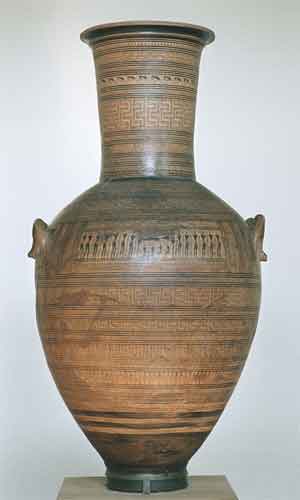Around the mid-eighth century BCE the human form of the Geometric period began to develop on Dipylon vases. These vases are very large in size (nearly two meters) and were used as grave markers, with craters marking the places of males and amphorae marking those of females. The vases were originally found in the Kerameikos cemetery in Athens which is flanked by two pylons, hence the derivation of the term “dipylon”. In addition to being grave markers, the vases could also be used as libation receptacles. They were made by being spun on a wheel and assembled in pieces and then painted in a Late Geometric style. Nearly fifty of these pieces have been attributed to the so-called Dipylon Master, who had a workshop that produced the vases between 760 and 735 BCE.
The vases are covered in rows of patterns and shapes which is typical of the Geometric movement, but more importantly they include scenes of funerary practices with depictions of humans and animals at the handle level. The most common scenes are of protheses (the lying down of a corpse) or ekphorae (a corpse’s procession with mourners on either side). In many representations one row is used to show the deceased on a bier flanked by mourners with sacrificial animals around while a second row below the first is used to show chariots, horses, and warriors with their figure-eight shaped shields. Made using black-figure techniques, each human consists of a triangle for a torso, a circle for a head, lines for the arms, and curved sections for the legs, which all provide a rather basic profile. In order to make their appearance recognizable, each figure is also given a sort of forward-facing position, as can be seen by the way the figures lying down are propped up on their sides. Indeed the idea of perspective became an issue when trying to represent a lot of things in the designs on these vases. The shrouds used to put over the deceased are represented as patterned veils painted literally above the lying down figures rather than over them so all parts can be seen. Also, even though horses are painted besides each other their legs are still all put in the same plane, showing that artists were still experimenting with demonstrating concepts like dimension and relative placement. Shapes are put in to fill any empty spaces in these scenes and the rest of the areas on the vases are also filled with rows of repetitive design, an element typical of the geometric movement.

Dipylon amphora showing a prothesis

Dipylon crater showing an ekphora

Detail of an ekphora showing the corpse on its side and the shroud above
Works Cited:
Biers, William R. The Archaeology of Greece. Ithaca: Cornell University Press, 1996.
Whitley, James. The Archaeology of Ancient Greece. Cambridge: Cambridge University Press, 2001.
